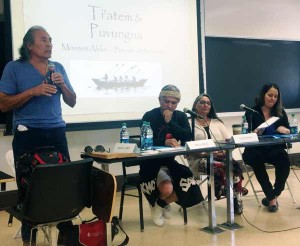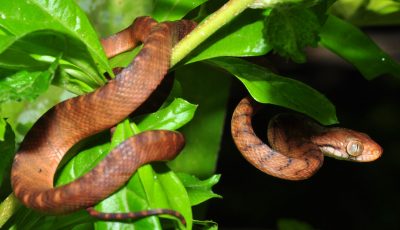Ancestors in training
Editor’s Note: This article, written by Alisia Tulua, describes a symposium held at the University of California, Los Angeles in April 2015. Symposium participants included a UCLA class taught by Dr. Keith L. Camacho, an associate professor of East Asian Studies.
Laughter pierced the silence of UCLA’s Haines Room, filled with students, activists, and community members, when a student asked about the tension between islanders that Lino Olopai describes in his book, The Rope of Tradition. Much of that laughter came from many of the indigenous people in the room; some are natives of the Americas and others are of Oceania.

Marcus Lopez, a Chumash Elder, gives his presentation. Also pictured are Mario R. Borja, Cindi Alvitre, and Kehaulani Vaughn (Contributed Photo)
The question was posed at a symposium hosted by UCLA’s Mapping Indigenous Los Angeles collective, titled “East Oceania: Indigenous Seascapes and Geographies.” The room was filled with more than 70 attendees and included UCLA students who read Olopai’s book as part of their Asian American and Pacific Islander Studies course’s required reading.
Professors, community leaders, families, and students shared the afternoon with distinguished speakers from the Tongva and Chumash tribes of California alongside Chamorro and Kanaka ‘Ōiwi of the Marianas and Hawaii, respectively.
The centerpiece of the symposium was the canoe, whose structure and utility connects these indigenous communities in time, past and present. Cindi Alvitre, a Tongva professor of American Indian Studies at California State University, Long Beach, shared the dream and images that brought the vision of her Tongva ti’at/canoe made of sewn-plank redwood.
The sewn-plank canoe exists in the Pacific and is the same construction of the Sakman Chamorro—a Chamorro outrigger canoe that is a project of Mario R. Borja and his seafaring community in San Diego, California. Borja, originally from Saipan, shared the project as a channel for reviving the Chamorro culture for the children. “We must hide our culture in our children. Culture begets language begets culture,” he said.
Kehaulani Vaughn, a Native Hawaiian doctorate candidate of Ethnic Studies at the University of California, Riverside, echoed and emphasized the importance of continuing traditions as a means to understanding “survivance, the indigenous self-determining practices” that will ensure our survival.
Marcus Lopez, a Chumash Elder, who paddles in the tomol/canoe which has regularly crossed from Ventura to Santa Cruz Island over the past 20 years, honored the symposium with a closing blessing.
Each speaker drew their connection to indigenous seascapes through a unique natural element. For Alvitre it was the soapstone at Catalina Island; for Borja it was the wood that brought everyone together; for Vaughn it was the acknowledgement of the land and its resources. The symposium revealed the mandatory and dependent bond that canoe cultures have with nature and the environment.
A stream of wisdom that flowed through each of the messengers was that the sustenance needed to pass on these cultures depended on how well indigenous sensibilities are honed to care for the waning natural resources these narratives depend on. Indigenous knowledge’s common dependence on nature is best illustrated by Lopez when he stated, “Seeing skies is as important to our lives today as they were in yonder days!”
Chris Vaimili, a Samoan community organizer for Empowering Pacific Islander Communities, was astounded at the commonalities and connections shared by these indigenous communities. “It is amazing that we can look at something that was essential to our existence in the islands, like the canoe, and draw similarities with the indigenous people of California. It makes you think about how connected our people were with one another before Western contact.”
Linking indigenous cultures to contemporary understanding engaged attendees in conversation about efforts to revitalize canoe building, canoeing as a sport in these cultures (at least for some Pacific Islanders), and relationships between communities.
The symposium allowed for cross-culture and cross-discipline sharing. It was clear that many were beginning to build on Borja’s encouragement to foster relationships because “we are all ancestors in training.”
Alisi Tulua is the chief operating officer of Empowering Pacific Islander Communities, a non-profit organization located in Los Angeles and dedicated to civic engagement, community advocacy, educational research, and leadership development in California and the United States.



























